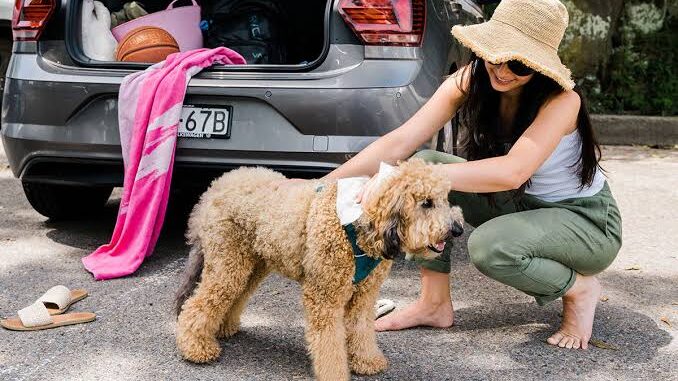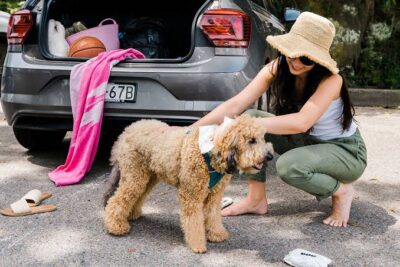
Taking your dog to new places can be an exciting adventure for both of you, but it’s essential to ensure their safety in unfamiliar environments. Whether you’re going on a trip, visiting a park, or exploring a new neighborhood, there are several precautions you can take to make sure your dog stays safe and enjoys the experience.
How to Keep Your Dog Safe When Visiting New Places

1. Prepare Your Dog for New Experiences
Before heading to a new place, it’s important to prepare your dog for the experience. Start with some basic training and socialization to help your dog become comfortable in different environments and around new people and animals.
- Socialization: Take your dog to dog-friendly places such as parks or pet stores to help them adjust to different sounds, smells, and people.
- Training: Ensure your dog responds well to basic commands like “sit,” “stay,” and “come.” This can help you maintain control if you’re in a situation where your dog might get anxious or excited.
2. Bring Essential Safety Gear
Having the right equipment is crucial when traveling with your dog. Some basic safety gear includes:
- Leash and Harness: A sturdy leash and harness will give you more control and prevent your dog from running off in unfamiliar places. Harnesses are especially helpful for dogs that tend to pull.
- Identification: Ensure your dog is wearing an ID tag with up-to-date contact information, and if possible, have them microchipped. This will help in case they get lost in a new environment.
- Travel Crate: If you’re traveling by car, bringing a travel crate can help keep your dog secure. It’s also a great way to give them a safe space to relax during trips.
- First Aid Kit: A basic first aid kit can be a lifesaver for minor injuries or health issues that may arise during your outing.
3. Be Mindful of New Environments
New places can present hazards for your dog. Whether it’s a new park, a beach, or a friend’s house, being mindful of your dog’s surroundings can help prevent accidents.
- Check for Toxic Plants: Some plants are toxic to dogs, such as lilies, azaleas, and foxgloves. Before letting your dog explore, check the area for potentially harmful vegetation.
- Avoid Hot Pavement: If you’re visiting a new city or town, be mindful of the temperature of the pavement. Hot surfaces can burn your dog’s paws. Try to walk during cooler parts of the day, and avoid walking on asphalt or concrete if it’s too hot.
- Leash Law Compliance: Some places have leash laws that require dogs to be kept on a leash at all times. Make sure to follow these laws to avoid fines and keep your dog safe from other animals or traffic.
- Keep an Eye on Water: If you’re near water, be cautious about your dog’s safety. Not all dogs are strong swimmers, and they may get into dangerous situations in lakes, rivers, or oceans. Always supervise your dog around water.
4. Monitor Your Dog’s Behavior
When visiting a new place, it’s important to observe your dog’s behavior closely. Signs of stress, discomfort, or fear may indicate that your dog is not enjoying the experience. Some common signs include:
- Whining or excessive barking
- Trembling or cowering
- Avoiding eye contact or hiding
- Refusing to walk or explore
If you notice these signs, try to create a calm and reassuring environment for your dog. If your dog is still uncomfortable, consider cutting your trip short and returning to a familiar place.
5. Know Your Dog’s Limits
Some dogs are more adaptable to new experiences than others. It’s important to recognize your dog’s personality and comfort level. For instance:
- Shy or anxious dogs may need more time to adjust to unfamiliar places, so start with shorter trips and gradually increase their exposure to new environments.
- Energetic dogs might get overly excited in new surroundings, so make sure they get enough physical exercise before heading out to help burn off some energy.
- Senior dogs or dogs with health conditions may not tolerate long trips or strenuous activities. Always check with your vet before embarking on a lengthy adventure.
6. Hydrate and Snack Regularly
Traveling or visiting new places can be tiring for your dog. Always make sure to bring water and some snacks to keep them hydrated and energized. If your dog has special dietary needs, pack their regular food or any medications they may require.
- Portable Water Bottle: Carry a collapsible water bowl and a portable water bottle to make it easy for your dog to drink water on the go.
- Healthy Snacks: Bring along some treats or dog-safe snacks to reward your dog and provide a boost of energy when needed.
7. Consider Pet Insurance
If you’re planning a longer trip or visiting a remote area, consider getting pet insurance or making sure you have access to a local vet. Some pet insurance plans cover travel emergencies, and knowing where the nearest vet is can be crucial if something goes wrong.
READ ALSO: 10 Fun Activities to Keep Your Pet Active and Happy
FAQs
How can I tell if my dog is stressed in a new environment?
Look for signs such as excessive panting, drooling, whining, cowering, or refusal to engage with their surroundings. If your dog seems anxious, take a break and allow them to rest in a calm environment.
Are there any dog-friendly places I should avoid?
Be cautious of areas with dangerous wildlife, busy roads, or areas known for aggressive dogs. Additionally, always check if the location is safe for dogs and whether they have appropriate facilities like shade, water, or bathrooms for pets.
Can I take my dog to a new restaurant or café?
Many dog-friendly restaurants or cafes allow pets on patios or in designated outdoor areas. Always call ahead or check online to ensure the place is pet-friendly and review any specific rules they may have for dogs.
What should I do if my dog gets lost in a new place?
If your dog goes missing, remain calm and immediately begin searching the area. Use your dog’s microchip or ID tags to help someone identify your dog if they’re found. You may also want to contact local authorities or animal shelters for assistance.
How can I keep my dog safe in busy public places?
Always keep your dog on a leash and avoid letting them interact with unfamiliar dogs or people without supervision. If your dog is anxious in crowds, consider avoiding busy areas or finding quieter spots for your dog to relax.
Is it safe to let my dog off-leash in unfamiliar areas?
Unless you’re in a fully enclosed area like a dog park, it’s best to keep your dog on a leash. This ensures that you have control over your dog in case of sudden distractions or dangers.
Leave a Reply
You must be logged in to post a comment.